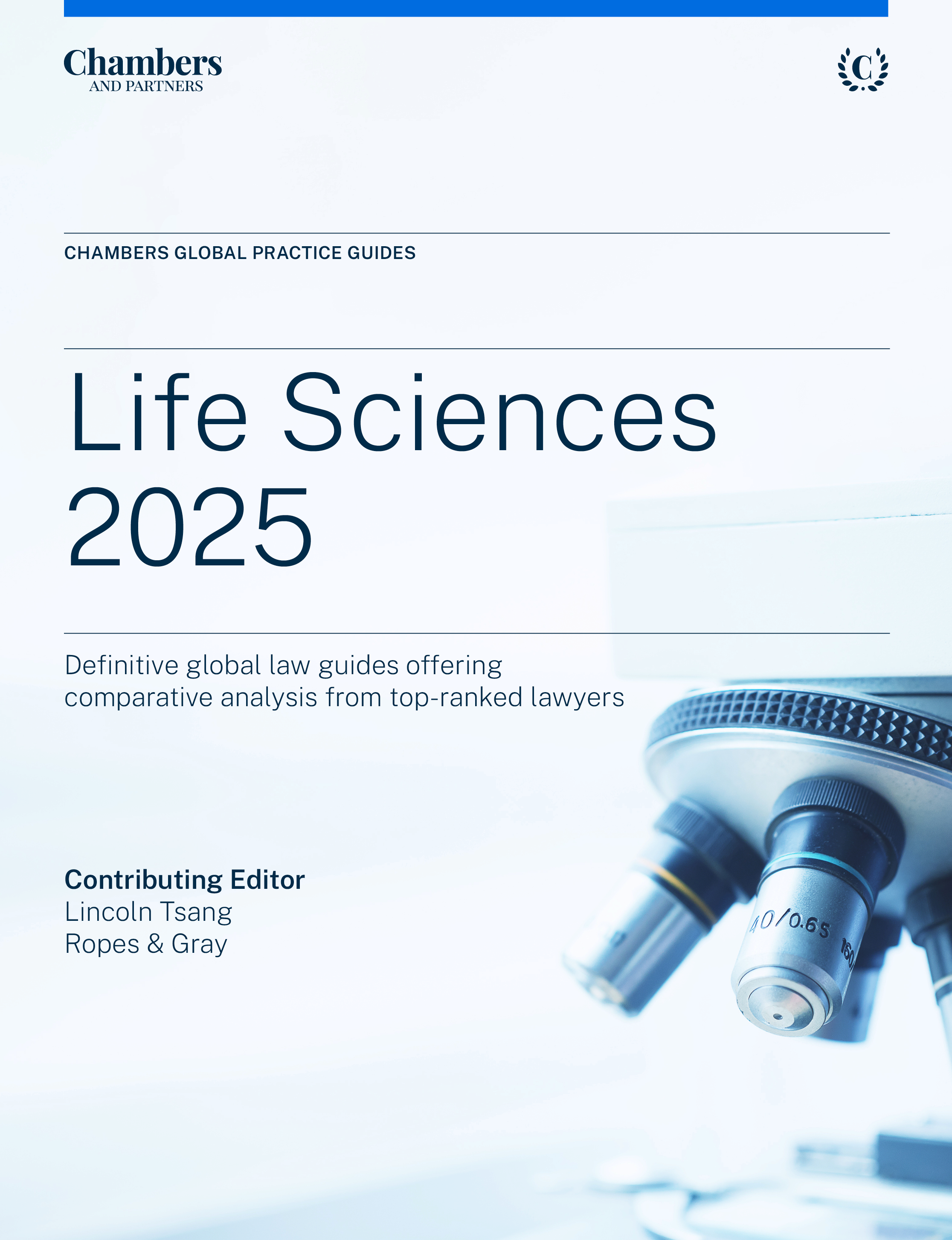
Life Sciences 2025
The new Life Sciences 2025 guide features close to 20 jurisdictions. The guide provides the latest legal information on the regulatory framework for life sciences; clinical trials; the marketing, manufacturing and distribution of pharmaceuticals and medical devices; their import, export and pricing; and regulatory reliance and fast-track registration.
Last Updated: April 03, 2025
Compare law and practice by selecting locations and topic(s)
Select Locations

Select Topic(s)

Please select at least one location and one topic to use the compare functionality.
A Brave New World of Evolving Global Life Sciences Landscapes
Welcome to the 2025 edition of Chambers and Partners’ Life Sciences Global Practice Guide. As the new contributing editor for this publication, I wish to express my gratitude to colleagues for their expert contributions to this Guide. They have collectively covered the latest developments in a wide range of regulatory compliance, legal and policy issues in their respective jurisdictions. In addition, I wish to take the opportunity to make a few opening remarks.
The life sciences and healthcare sector represents a major knowledge-based global economy. It is anticipated to grow to approximately USD4 trillion by 2033, poised for some breath-taking technological and medical transformations, driven by digitalisation and by the increasing convergence of biological, physical and computer sciences to expedite identification of novel therapeutic targets, novel materials, and new methodological approaches to evaluating the safety, quality, and clinical effectiveness of innovations.
Post-pandemic challenges
March 2025 marks nearly five years since the World Health Organization (WHO) officially declared the COVID-19 pandemic, beginning one of the most challenging periods in recent times. The pandemic also tested the resilience of the life sciences and healthcare sector at all levels. The sector has adapted its practices – and continues to do so – through increased agility and collaboration, spanning the full spectrum of R&D as well as healthcare delivery activities.
The industry has begun to stabilise after the WHO lifted the global public health emergency status for COVID-19, given that the disease is now considered to be ongoing and well established. Yet now the world is confronted with a new wave of macroeconomic challenges such as high inflation and the rise in energy prices. Geopolitical friction is the new frontier that has contributed to the faltering of economic growth. Many economic commentators have remarked that high geopolitical risk has been associated with lower equity returns and higher forecast volatilities, as well as uncertainty in investment decisions. The Institute of International Finance has indicated that the global debt levels are extraordinarily high, with USD60 trillion added since 2020. The life sciences sector is not immune to these existential economic vulnerabilities.
Trade policy changes under new Trump administration
The second term of the Trump administration in January 2025 – overseeing the world’s largest national economy and leading global trader – has started with some significant trade policy changes to achieve the USA’s economic and trade-related objectives. The Trump administration has justified such trade measures as rebalancing the country’s large and persistent annual trade deficit in goods, where closed markets abroad have reduced US exports and open markets in the USA have resulted in significant imports.
These changes have already sent shockwaves around the world, as the new trade policy has broken with decades of free trade policy – in recognition of globalisation, which involves increasing integration of economies around the world – by imposing tariffs on a number of key economic regions, including the USA’s traditional allies. At the time of writing (April 2025), the new US President famously considered 2 April 2025 as the “tariffs day”/“liberation day” on which the new tariffs will be enacted unless the tariff and non-tariff barriers are equalised.
EU countermeasures
The EU and the other US allies have already introduced a series of countermeasures. Trade measures and countermeasures were imposed by the EU (in 2018 and 2020 respectively) during the first Trump administration, primarily in response to the US tariffs on European steel and aluminium exports. These EU countermeasures were structured into two sets of measures, each affecting different product categories. The EU measures and countermeasures introduced in 2018 and 2020 were subsequently suspended until 31 March 2025 or otherwise will be reactivated on 1 April 2025 to give the USA and the EU the opportunity to work out a longer-term solution. In response to the new US trade measures on European goods of 12 March 2025, on the same day the EC defended European interests in response through two sets of counter-measures – namely, the reimposition of the suspended 2018 and 2020 rebalancing measures, and the imposition of a new package of additional measures.
The EU’s trade countermeasures were initiated by the EC according to the EU Enforcement Regulation 2014, which enables the EU to suspend concessions or other obligations under international trade agreements with the intention of rebalancing concessions or other obligations in trade relations with third countries when the treatment accorded to goods from the EU is altered to such an extent that affects the EU’s interests.
This rebalancing of concessions or other obligations is permissible under international trade law as now reflected in EU law. Specifically, a member of the WTO can apply a safeguard measure or seek an extension of a safeguard measure based on objective criteria (defined in EU law) in order to suspend tariff concessions and to impose new or increased customs duties. These objective criteria set out in EU law are:
- effectiveness in inducing compliance of third countries with international trade rules;
- potential to provide relief to economic operators within the EU affected by third-country measures;
- availability of alternative sources of supply for the goods concerned in order to avoid or minimise any negative impact on downstream industries, contracting authorities, entities, or final consumers within the EU;
- avoidance of disproportionate administrative complexity and costs in the application of the measures; and
- any specific criteria that may be established in international trade agreements.
Impact on life sciences and healthcare sector
The uncertainty surrounding the trade tariffs will likely increase the costs on goods and hence increase price spikes, disrupt the supply chains, and bring about serious supply shortages. This is particularly impactful for the life sciences and healthcare sector, which has relied upon on international trade and an interconnected global economy in order to research, develop and manufacture healthcare products – particularly essential and critical medicines, as well as healthcare products that global citizens have taken for granted. Supply shortages will have seriously momentous consequences on public health and patient care. The COVID-19 pandemic also emphasised the increasing interdependency and interconnectivity of various geographical regions in providing raw materials for the manufacture and distribution of critical public health countermeasures for hospitals, including prophylactic vaccines and personal protective clothing.
Moreover, the trade wars will hurt the ongoing global development of AI and digital health. Tariff and export control policies will have much larger effects on AI hardware supply chains.
Industry has already responded by urging the Trump administration and the EU to exclude medical products from expanding tariff wars, in the hope of avoiding price increases and supply shortages.
On 2 April 2025, President Trump issued an executive order (the Reciprocal Tariffs Executive Order) imposing a reciprocal tariff of 10% at baseline on all US trading partners, effective 5 April 2025. An additional reciprocal tariff will be imposed on 57 countries, effective 9 April 2025. Annex II to the Reciprocal Tariffs Executive Order excludes certain named medicines or categories of medicines ‒ as well as key ingredients used in drug formulation ‒ from the reciprocal tariffs. However, it is not apparent that the exclusion applies to medical devices and medical technologies – although semiconductor devices and semiconductor-based transducers are excluded. Tariff relief for pharmaceuticals could be short-lived, as the Reciprocal Tariffs Executive Order contemplates applying the so-called Section 232 investigation to pharmaceuticals alongside lumber, semiconductors, and other sectors. Sector-specific import duties could be on the horizon following such an investigation, given the declared Trump policy to strengthen the USA’s pharmaceutical manufacturing capacity so as to avoid relying on imported medicines. Following the President’s decision to pause many of the tariffs worldwide for 90 days, the EU suspended retaliatory counter-tariffs on 10 April 2025; however the interim measures do not remove the trade uncertainties.
The impact of commercial trade policies has not attracted a great deal of attention in the life sciences sector until very recently. This is largely because, since the late 1980s, key geographical regions – through the processes of the International Council for Harmonisation (in the case of pharmaceuticals) and the Global Harmonisation Task Force (now rebranded as the International Medical Devices Regulatory Forum) – have striven to promote harmonisation efforts to standardise regulatory requirements in order to minimise friction in the transboundary movement of medicines and healthcare products.
Changing role of USA in global public health
The WHO also has a pivotal role in promoting global public health and global harmonization. The USA has been by far the biggest financial contributor to the WHO’s global health initiatives, contributing circa USD960 million. On 20 January 2025, the executive order by the President famously entitled “Withdrawing the United States from the World” gave official notice of the USA’s intention to withdraw from the WHO, citing grounds arising from the WHO’s mishandling of the COVID-19 pandemic and other global health crises, its failure to adopt urgently needed reforms, and its inability to demonstrate independence from the inappropriate political influence of WHO member states.
The significant leadership change in US healthcare regulation will also likely result in potentially seismic legislative and policy regulatory policy changes, as well as challenge operational resilience in a number of key federal public health agencies. These can be globally impactful, given that the USA has significant influence on the global regulatory compliance landscape and has been instrumental in leading many international co-operative initiatives. Moreover, the new Trump administration has already declared its desire to trim down the government and reduce federal spending under the directions of the Department of Government Efficiency (DOGE). The new policy has already caused substantial rippling effects.
The question will remain as to whether the USA will continue to play a global leadership role and maintain the treasured internal scientific expertise to usher the global public health and patient safety agenda. Only time will tell.
